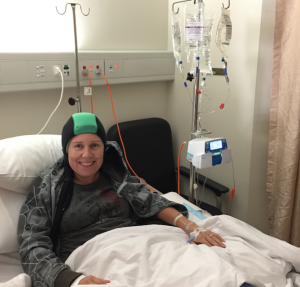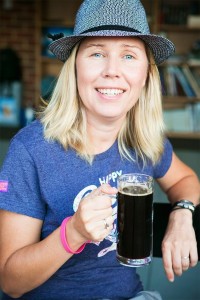Belinda, 40: Forensic scientist, keen cyclist & CIA trial patient recovering from breast cancer, PERTH
The life of happily married forensic scientist and avid cyclist, Belinda, 40, Perth was turned upside down when she received a diagnosis of stage two breast cancer on October 13, 2015.
The self-described “stoic, upbeat, positive person” initially noticed a distortion of her left breast in September, 2015 while rehabilitating from a shoulder injury. She had no other common breast cancer symptoms though, such as pain or discharge, and was even unable to feel the lump in her breast.
Concerned for her own welfare, Belinda visited her GP and on October 5, 2015, underwent her first of two ultrasounds to explore the issue. The results were unclear. Four days later, Belinda subsequently had a second ultrasound, along with a mammogram and biopsy.
On October 13, 2015 she visited leading breast cancer surgeon, Dr Peter Willsher, Perth, who examined her breast and confirmed she was living with oestrogen receptive breast cancer.
This is Belinda’s story.
“I had a shoulder operation in May, 2015 and in September, 2015, was performing my routine rehab exercises external to hospital, when I noticed a distortion in my left breast. When I lifted my hand above my head, it looked as though I was missing the lower quarter of my left breast,” said Belinda.
Growing increasingly concerned about her breast distortion, Belinda visited her GP on September 30, 2015, and five days later, underwent an ultrasound. Armed with ambiguous results, her GP called her the following day, insisting she undergo another ultrasound as well as a mammogram and a biopsy – all of which were scheduled for October 8, 2015.
On October 13, 2015 Belinda visited Dr Willsher who confirmed her worst fears – she was living with stage 2 breast cancer. He requested she undergo an MRI to paint a more detailed picture of her breast cancer, and to help him determine the type of breast cancer surgery she would require.
“When I was diagnosed with breast cancer, I didn’t cry. Although it was not what I wanted to hear, it wasn’t until I received the MRI results that confirmed I would need a mastectomy, that I became emotional,” Belinda said.
“Honestly, I was more stressed about the financial cost of the journey I was about to embark upon, than actually having breast cancer, because my private healthcare didn’t cover breast reconstruction.”
In the ensuing week, Belinda saw plastic surgeon, Dr Paul Quinn, who discussed the different types of breast reconstruction available to her. She elected to undergo a latissimus dorsi (LD) flap reconstruction, whereby the back muscle is transferred to the front region of the breast to create tissue, and an expander is inserted to create room for the breast implant. This is a two stage process with the exchange surgery due in July, 2016.
 A keen cyclist, Belinda participates in ‘sockdoping’ – a movement whose followers display their cycling socks. When admitted to hospital for surgery on October 29, 2015, Belinda uploaded a picture of her feet to Instagram, lying in her hospital bed wearing a pair of cycling socks, together with the hashtag, #sockdoping4cancer. This hashtag became pivotal to Belinda’s recovery process, for she continued to document her 150-day-long recovery process by taking a photo of her feet adorned with a different pair of socks, which she leveraged via her Instagram channel using the same hashtag for 150 days, urging people to follow her and donate socks and funds to help cover her substantial breast cancer treatment costs. Socks and funds flowed in from all around the world in support of Belinda and her recovery.
A keen cyclist, Belinda participates in ‘sockdoping’ – a movement whose followers display their cycling socks. When admitted to hospital for surgery on October 29, 2015, Belinda uploaded a picture of her feet to Instagram, lying in her hospital bed wearing a pair of cycling socks, together with the hashtag, #sockdoping4cancer. This hashtag became pivotal to Belinda’s recovery process, for she continued to document her 150-day-long recovery process by taking a photo of her feet adorned with a different pair of socks, which she leveraged via her Instagram channel using the same hashtag for 150 days, urging people to follow her and donate socks and funds to help cover her substantial breast cancer treatment costs. Socks and funds flowed in from all around the world in support of Belinda and her recovery.
In November, 2015 Belinda met with Breast Medical Oncologist, Director Breast Clinical Trials Unit and Vice-Chair, Breast Cancer Research Centre – WA (BCRC-WA), Professor Arlene Chan, Perth, to discuss her treatment options, the latter of whom recommended she undergo chemotherapy.
“Prof Chan wanted me to start chemo before Christmas, but I didn’t want to go bald before then, so I organised to commence my treatment on Jan 13, 2016,” said Belinda.
“Interestingly, before I saw Prof Chan on January 13, 2016 a friend of mine had tagged me on Facebook regarding the DigniCap® – a device that cools the scalp during chemotherapy, reducing blood flow (and thereby decreasing the amount of chemotherapy that reaches a patient’s scalp) and slowing down normal hair follicle cell activity. It looked interesting but at the time I mistakenly thought it was only available in the US, so didn’t give it too much more thought.
Determined to control her own hair loss, rather than to lose it “in clumps” to “gruelling chemotherapy”, Belinda, together with her best friend, Ronia, hosted a fundraising “hair shaving party” with cycling friends, at which they both shaved their heads together, the evening prior to Belinda’s commencement of chemotherapy.
When Belinda visited Prof Chan the following day, she was surprised to see that Belinda had shaved her head prior to undergoing chemotherapy, because she was planning to invite Belinda to enrol in the BCRC-WA Chemotherapy Induced Alopecia (CIA) trial, designed to prevent or minimise hair loss during treatment, and assess impact on patient quality of life (QoL). This was using the same DigniCap® that Belinda had seen on Facebook.
Fortunately, despite having shaved her head, Prof Chan explained there was still a possibility that she could retain some of her hair if she participated in the trial.
“By this point, I had come to terms with the likelihood of losing my hair to chemo. So when Prof Chan explained I could enter the trial and potentially not lose my hair, I was very excited!” said Belinda.
“As a research scientist, I’m fond of research. The CIA researchers were also keen to investigate whether the DigniCap® would work for me, given I had just shaved my head. So I started my chemo and DigniCap® treatment that day.”
Belinda’s DigniCap® treatment was set at five degrees celcius and commenced 30 minutes prior to her chemotherapy, to cool down her scalp. The cool cap then remained on her head throughout her chemotherapy infusion, and for another 90 minutes post- chemo treatment.
“For the first three weeks after chemo and use of the DigniCap®, I experienced no hair loss whatsoever. In fact, very surprisingly, my hair started to grow back! After four weeks of starting chemo, my hair was eight millimetres long, and by the end of my chemo nine weeks later, my hair was 27 millimetres long.”
Belinda completed her participation in both the CIA trial and her chemotherapy on March 16, 2016. During this period, she maintains she experienced “minimal hair loss overall”, and because of this, claims to have “never felt like a typical cancer patient.”
“I had a very positive experience with the DigniCap®. My hair is now quite thick and straight, with a bit of a wave at the back. I would highly recommend it to others set to commence chemotherapy, who wish to retain their hair.
“Throughout my treatment, I was never really afraid of the cancer and the prospect of it beating me. But I didn’t want to look like a cancer patient, so I’m very grateful to Prof Chan for granting me the opportunity to participate in the CIA trial,” Belinda said.

